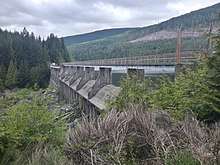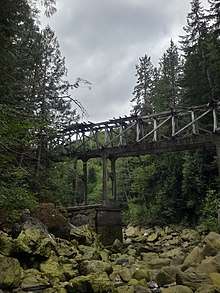Jordan River Dam
The Jordan River Dam, officially the Jordan River Diversion Dam, and known locally simply as Diversion Dam, is a dam located in Jordan River, British Columbia, Canada. It is part of the second hydroelectric development on Vancouver Island.[1]

History

Prior to the dam's construction, the Lubbe Powerhouse was the main source of electricity to Victoria. Upon completion, it dwarfed the previous plant.
The Vancouver Island Power Company, a subsidiary of British Columbia Electric Railway, completed construction of the smaller Bear Creek Dam and the main Jordan River Diversion Dam in 1911. At 126 feet (38.4 metres) from top to bottom, the Diversion Dam was upon its construction, the highest dam in Canada.[2] Water flowed through a 31,600ft long flume to the penstock above the power house.[3] The construction of the dam, due to its remoteness, required the construction of a three-foot narrow gauge railway as well as a cable-railway for the initial ascent from Jordan River.[3] From 1912 to 1931 continual improvements and additional generators pushed the capacity of the power house to 26 megawatts.
In 1971 the flume was replaced by a 7 km tunnel, with a penstock flowing down to a new power house, located across the river from the original. The same year, the accompanying service railway was also dismantled. A Japanese built generator replaced the old equipment, boosting power output from 26 megawatts to 175 megawatts.[4]
Current operation
Water collected at Bear Creek Dam and Diversion Dam, is then used to fill Jack Elliott equalization reservoir on demand and flows from there through a 8.8 km (5.5 mi) long tunnel into a steel penstock for the last 330 feet (101 metres) of vertical height. It provides 35% of Vancouver Island's generating capacity.
In 1996, the provincial government initiated a Water Use Planning (WUP) program, demanding that BC's water licence holders show they can manage the potential environmental impact of reservoirs. in 2001 the Jordan River "WUP" was underway, with restoration of fish habitat a top issue.[5]
A 2014 BC Hydro study indicated Jordan River had a high risk of seismic dam failure. BC Hydro has offered to purchase the nine residences in the evacuation zone.[6]
References
- Peers, Elida (March 2007). "Jordan River Powerhouse". Rural Observer. Archived from the original on 2008-05-16.
- https://www.for.gov.bc.ca/hfd/library/documents/bib50653.pdf Water Powers British Columbia Canada
- Ewert, Henry (1986). The Story of the BC Electric Railway Company. Vancouver, British Columbia: Whitecap Books Ltd. p. 76. ISBN 0-920620-54-X.
- Newcomb, John. A source of Victoria's power, 18 March 2001 (pdf 140K). geog.Uvic.ca Archived 13 February 2012 at the Wayback Machine
- Newcomb, John. A source of Victoria's power, 18 March 2001 (pdf 140K). geog.Uvic.ca Archived 13 February 2012 at the Wayback Machine
- https://www.bchydro.com/energy-in-bc/our_system/generation/dam-safety/jordan-river-options.html
External links
See also
- HVDC Vancouver Island
- Powerlines connecting Vancouver Island with Canadian Mainland
- List of generating stations in BC
- List of dams and reservoirs in Canada
- Lubbe Powerhouse